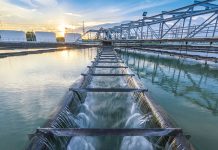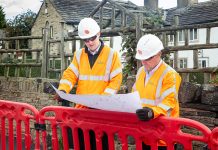Severn Trent is beginning to roll out new ground breaking technology to remove phosphorus from the sewage treatment process to meet new stringent targets.
The company has been trialling seven new technologies at its site in Packington, Leicestershire, two of which are world firsts, to find the best way to reduce the amount of phosphorus from water that is returned to the environment.
Severn Trent is investing around £120m in phosphorus removal technology up until 2020, an investment that will see around 100 sewage treatment works upgraded in order to meet new targets set by the Water Framework Directive.
The new legislation means that many of the works will have phosphorus limits of less than 0.5mg per litre with some as low as 0.2mg per litre.
Pete Vale, who is leading the project, said: “The Water Framework Directive requires us to meet much tighter phosphorus limits than we have in the past and our existing technology needs to be upgraded in order to comply with these new targets.
“That’s why we’ve been trialling several new types of technology at our site in Packington near Ashby-de-la-Zouch and we’re now getting to a stage where we can roll out some of the new tech across the region.
“The technologies on trial show a range of different techniques using physical, chemical and biological processes and we’re looking for different solutions for our different sites whether they are small, medium or large in size.
“We hope that by developing these we can get down to around the 0.1milligramme per litre level and greatly reduce the amount of phosphorus that goes back into our streams and rivers.”
Phosphorus is a normal part of domestic sewage but conventional treatment processes only remove part of it. Four of the technologies that have been tested at Packington are proprietary and three are novel and have been developed by Cranfield University.
Pete continued: “During the trials we’ve been using some really state-of-the-art techniques to understand which technology will work for our sewage treatment sites that greatly differ in size – from very small local sites to one of the biggest in Europe.
“We’ve already taken some of the learnings and have installed some new technology at three plants with another nine in the planning process.
“This is just the beginning of the journey and we’ll be continuing this research to improve our phosphorus management practices and provide us with a more sustainable future.”
An important element of moving towards a more sustainable approach is to not only remove the phosphorus from the sewage, but to recover it in a useable and valuable form, for example as a fertiliser. Phosphorus is essential for all life. It can’t be substituted or replaced, and it is a scarce and dwindling natural resource. It is one of three major plant nutrients and is widely used in fertilisers.
Pete said: “One of the novel technologies we have been evaluating, an ion exchange process, removes the phosphorus from the sewage without the need to dose chemicals and then in turn the phosphorus can be recovered in the form of a useful mineral (calcium phosphate). If this process is successfully implemented it has the potential to reduce the UK’s reliance on importing mined natural phosphorus rock.”
The technologies being evaluated at Packington are: membrane filtration; nano-particle embedded ion exchange; pile cloth media filtration; ballasted coagulation and clarification; immobilised algal bioreactor; absorption media reed beds; and iron dosed sand filtration. The ion exchange and algal bioreactor, both of which were developed by Cranfield University, are being put into practical application for the first time.
The pile cloth media filters are now in place and operating at three sites with the technology selected to upgrade a further four sites. The technology, developed in Switzerland, uses a filter cloth on a disc or a drum to filter out the phosphorus containing solids that are generated by the dosing of iron immediately upstream of the filter. The technology has proven to be an effective, and typically lower energy, alternative to sand filters.
The ballasted coagulation and clarification process will also be installed at full scale at two sites in the near future. The process, developed on the east coast of the USA, is a three step process. The first step uses a coagulant such as iron to precipitate the soluble phosphorus, a magnetite ballast is then added to the water which acts as a seed for the precipitate and also to add weight to the solids. In the last step a polymer coagulant is added to help bind the precipitate and ballast together before flows enter a settlement tank where the solids settle quickly and efficiently. The sludge is removed from the base of the settlement tank but before the sludge is sent off for further treatment it is pumped through a magnetic drum. The magnetic drum recovers the magnetite from the sludge and from here it drops back into the process to be reused.





